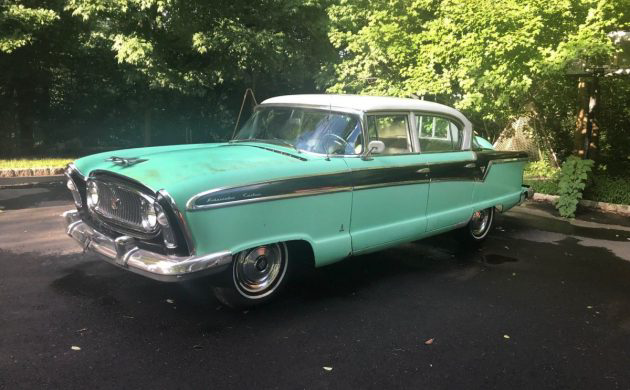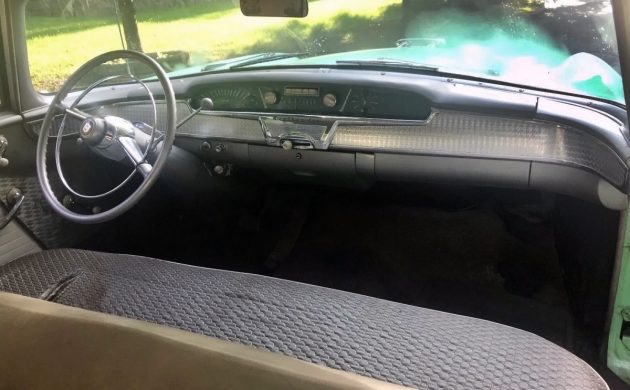Stored for 31 Years: 1956 Nash Ambassador Custom
If a person wanted to stand out from the Chevy or Ford crowd in the mid-1950s there was hardly any better way to do that than with a 1956 Nash Ambassador Custom like this example listed on eBay in Shelton, Connecticut. The seller has it listed with a $4,000 starting big which hasn’t been met yet. I like to stand out a bit rather than follow the crowd, how about you?
I can’t get enough of the 1950s Nash lineup, especially these big Ambassadors. That grille is to die for, it’s a fantastic piece of art in and of itself. This was it for Nash, the 1952 through 1957 cars. The company merged with Hudson to create AMC in 1954 and both Nash and Hudson were slowly phased out, but not before producing some very cool and unique cars. They’re more in the love-it-or-hate-it camp than a Chevy or Ford of the same era but that’s what draws me to them.
At just over 4,000 pounds this isn’t a light car but it’s a lot lighter than it looks. My ’66 Lincoln weighed over a half-ton more than this car does. The “Continental kit” spare tire on the extended rear bumper came with the Custom trim line as seen on this example. I can see some rust on the rocker panels which is always scary especially with a unit-body car. The seller says that this Ambassador was “Stored inside from 1981 – 2014” and they acknowledge the rust: “Some rust/rot on frame and unibody. Moved on to another project.” I get it, sometimes we just lose interest in a project and life gets in the way and we mentally move on. We’ve all been there – I’m there now.
This interior is nice, or it was and it could be again. It doesn’t look bad other than those tears in the driver’s side of the front bench seat. The back seat looks great and the dash is space-age-cool. 1954 was the first year that Nash offered what was the industry’s first front-mounted heating and air-condition system. We don’t think much about that now but it was a big deal and it was a big deal that Nash had it first. The Weather-Eye system was groundbreaking and how cool (no pun intended) was it that Nash-Kelvinator, a company that made a fortune on refrigeration equipment, had it first?
This engine is Packard’s 352 cubic-inch V8 with 220 hp and 320 ft-lb of torque and it’s backed up by their Ultramatic automatic transmission. This is one smooth setup. It’ll need some sorting out, fuel-system-wise, as the seller says that the “Gas tank removed and smaller clean tank installed in the trunk.” With a 0-60 time of about 11.5 seconds this isn’t a fast car but it would sure be a nice weekend cruiser. Are there any Nash fans out there?
Auctions Ending Soon
 2006 Ford Mustang Saleen S281 SCBid Now28 mins$18,000
2006 Ford Mustang Saleen S281 SCBid Now28 mins$18,000
 2002 Subaru Impreza WRXBid Now3 days$333
2002 Subaru Impreza WRXBid Now3 days$333
 1975 Chevrolet Corvette ConvertibleBid Now3 days$3,000
1975 Chevrolet Corvette ConvertibleBid Now3 days$3,000
 1964 Ford F-100 Camper CustomBid Now3 days$2,000
1964 Ford F-100 Camper CustomBid Now3 days$2,000
 2006 Jeep Wrangler SportBid Now5 days$10,500
2006 Jeep Wrangler SportBid Now5 days$10,500






Comments
Did Nash use the same grille in the Nash Healey as they did in this car?
no exactly the same but similar
No. The `51-`53 Nash Healeys used a modified version of the `51 bathtub Nash grille.
I believe this should be the 320 cu. in. version of the Packard V8, not the 352. Rare and unique automobile, but the “uni-body rust and rot” scares me.
This must be an early 1956 production model – AMC dropped the Packard V8 in favor of its own in 1956. The history of it is that AMC bought the Packard engines and transmissions in a “gentlemen’s agreement” wherein each company would buy components from the other. In this way they could benefit from some shared costs without actually merging.
However, Packard never held up their part of the bargain so George Romney ordered up a crash program for AMC to develop its own V8 engine, a 250 cubic-inch mill of 190 horsepower that debuted in the 1956 Nash Ambassador and Hudson Hornet.
This car also lacks the ground-breaking Nash All-Season Air Conditioning, at least there is no sign of it under the hood or in the dashboard. In addition to being completely in front of the car, the Nash AC system was notable for being the first to incorporate a magnetic clutch on the compressor. (On earlier systems you had to remove the drive belt to completely turn the system off.)
You’d definitely want to check underneath carefully on these cars. Nash touted the advantages of its single-unit construction bodies but they are very vulnerable to the tinworm. Some photos of the underside would have been nice.
In 56 the 250 was only in the Ambassador Special and Hornet Special which used the shorter Statesman and Wasp bodies. The 250 was not in the full sized Ambassadors and Hornets.
Thanks for the correction! I’d forgotten that detail, and that ‘splains the Packard engine.
That teaser shot of the rot inside the right rear door is a red flag waving frantically. “Looks like just a small iceberg, captain – Full speed ahead!”
Some undercar pics are definitely required here, if not a personal inspection armed with sharp probing instruments.
Nice car, though. Not the same old thing.
I love this car, but I would definitely be cautious about the underside of it! Definitely needs pictures of it so people can see what they are getting!
In the summer of 1965 I was dating a woman whose father had a car just about like this, maybe this car, in CT, about 20 miles away. It was in great shape, worth almost nothing, but I had a ’56 Chevy that was just fine.
He liked me better than she did, and I liked the car better than her, the relationship was ending, I was headed for the Air Force, and I felt badly about taking his car and not his daughter, and had no place to store it, so I passed on it. If the rot is not bad, it would be a great car to have, the workmanship was far superior to the Chevy’s and Fords of the day.
Ford or Chevy Crowd? huh? Nash Ambassadors were expensive cars and sold in the middle and upper price range, they competed with Buick, Chrysler and Mercury. Of course a Nash stands out from the Chevy and Ford crowd, for the money you’d pay, you’d expect it too.